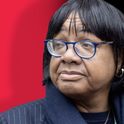After centuries contending with low level anti-papist sentiment, the Roman Catholic church in Britain is basking in public acclaim. What is more surprising for this secular age, it is even enjoying a certain kudos. The Independent notes a "current craze for catholicism," attributing it to a "loss of confidence with England's national church" and a "dearth of anglican thinkers." The Guardian estimates that "the game is going very much Rome's way" and that the "loss of confidence in the Church of England has become palpable... it is enfeebled as an institution and failing to provide moral firmness, ritual and sense of continuity." Charles Moore, one of the trophy converts to catholicism, along with the Duchess of Kent, Ann Widdecombe and John Gummer, comments on the Church of England thus: "Its public, moral stances seemed indistinguishable from those of a reasonably decent, mildly left-wing agnostic..."
This is an extraordinary phenomenon; catholicism's unexpected kudos bears no relationship to what is actually going on in the catholic church in Europe and the US, nor even to what is going on in England, in those traditionally working class catholic cities such as Liverpool. The Vatican must be as puzzled by the acclaim as George Carey, the Archbishop of Canterbury, is infuriated.
Non-believers prefer Catholicism
One of the main explanations behind the phenomenon is that catholicism matches the preconceptions of what non-believers believe a religious institution should be about: authority. Catholicism supplies this in the way no other religion can match with a clearly identifiable figure who hands out a set of categorical rules about what is right and what is wrong. The Vatican plays its part by, for example, issuing lists of acceptable and unacceptable films which are picked up and applauded by the secular press.
Meanwhile the Church of England has become the nation's favourite punchbag. The secular mind has no sympathy for anglicanism's apologetic, stumbling compromises in its struggle to accommodate the late 20th century. The long battle over women priests (which pushed 300 anglican priests into the catholic church), not to mention recent theological revisions such as deciding that hell does not exist, and that "living in sin" is an unhelpful concept, do nothing to enhance anglicanism's reputation among non-believers. Secularists may loathe the pope's stance on contraception, abortion, women priests, or priestly celibacy, but at least, runs the argument, it is consistent and shows no vacillating attempt to conciliate public opinion.
Furthermore, an impressive phalanx of traditionalist catholic writers have become increasingly vocal about their faith-Paul Johnson, Piers Paul Read, William Oddie, Alice Thomas Ellis, William Rees-Mogg. It would be hard to think of a comparable list of anglican apologists. They have conferred intellectual self-confidence on catholicism and have defined its public voice.
But the biggest asset the catholic church has in Britain is Cardinal Basil Hume. It is remarkable how effusive in their praise are those who have had dealings with him: they describe him as self-effacing, humble and spiritual. He is also a good diplomat who exploits the advantages of not being the head of the established church; he carefully chooses the issues on which he wants to speak out-miscarriages of justice, homelessness and asylum-and is able to sidestep the thorny issue of royal remarriage and coronation oaths which are set to dog the Church of England for years to come. He has plotted a course between traditionalists and modernisers within the church by combining campaigns on social issues with an orthodox theology; he takes no gambles on issues such as priestly celibacy, Aids, condoms or contraception. This has won him warm approval from the Vatican which has, in return, been noticeably careful in its dealings with Britain.
Hume's sure touch and dignity confer an establishment status that the catholic church has not had in this country since the Reformation. The publication in October of the pre-election briefing, The Common Good, was described as a "pivotal moment" for catholicism in Britain by the catholic weekly, The Tablet; the catholic church was no longer seen as a barely tolerated foreign institution, but as a legitimate participant in national life. When the Queen stood on the steps of Westminster Cathedral beside the cardinal a year ago after attending vespers, she was also tacitly admitting this transformation. Both were dressed in brilliant scarlet and braved the cranky protestants berating the monarch for breaking her coronation oath.
Royal approval cements catholicism's social cachet. A string of converts, led by the Duchess of Kent, has brought some glamour, social status and even political clout. Elizabeth Hurley is said to be toying with the idea of Rome and the Princess of Wales is viewed as convertible.
Catholicism in Britain used to be synonymous with the Irish immigrant working class. But as catholics have become upwardly mobile and lost their Irish cultural identity, the old snobbery has been eroded. The work of public schools such as Ampleforth in providing a catholic elite to govern the country alongside the products of Eton and Winchester has born some fruit-most notably, Lord Nolan.
Even the smells and bells and gloomy lighting which were once viewed as distinctly un-English have been appropriated as trendy artefacts. There is the fad for Gregorian chant in the charts, and the proliferation of thick, fat ecclesiastical candles in every house decor department. Jack O'Sullivan, a columnist on the Catholic Herald, recently pointed out that he felt entirely at home in Donna Karan's DKNY Bond Street flagship store with its minimalist stone recesses and soft lighting; it induced the same sense of the sacred as a church, the only difference being that the object of such emotions was clothes rather than saints.
Riding the randy roddy affair
But in recent months two incidents have suggested that beneath its public face the catholic church is as torn between modernisers and traditionalists as its anglican counterpart. It is a measure of the durability of catholicism's new status that it has emerged from these two incidents relatively unscathed.
First, Alice Thomas Ellis complained bitterly about Archbishop Derek Worlock's liberalism shortly after his death, prompting a howl of protest from Worlock's many devoted admirers. It gave a glimpse of division but the incident quickly disappeared under a blast of contemptuous scorn from a few prominent catholic commentators.
The second incident, involving "Randy Roddy," the Bishop of Argyll and the Isles, was altogether more tricky. Initially it seemed the scandal would be a disaster for the catholic church. What is wrong with a man falling in love and wanting to marry a woman? This seemed to be the common perception even among catholics. How could an institution which proclaimed itself to be compassionate force men to choose between priesthood and love, consigning many of them to loneliness and sexual frustration? But then the scandal shifted: first Joanna Whibley, the mother of Bishop Roderick Wright's 15-year-old son, revealed that he had kept her waiting with false promises, and then he forsook all sympathy by selling his story to the News of the World. After a week of nail-biting, the catholic church heaved a sigh of relief. He no longer challenged the whole system, he was just one very bad apple.
What this tale of popular perceptions of catholicism reveals is, first, how deeply alien the faith is to the protestant-or erstwhile protestant-English. The protestant English imagination is still titillated-both repulsed and fascinated-by its identification of catholicism with authority and obedience, mystery and sensuality.
Second, it shows how different Britain still is from Europe. In the conflict between institutional religion and secularism in Britain, it is the anglican church which has been in the frontline. Elsewhere, and particularly in catholic countries, it is the catholic church. Viewed from Europe or the US, catholicism in Britain seems a strange backwater, cut off from the debates and protest movements which are convulsing the church elsewhere. For example, who knows anything of Bishop Jacques Gaillot of France, sacked from the bishopric of Evreux for his radicalism and who has now set up his virtual reality diocese of Partenia on the internet?
The current fad for catholicism says more about disillusioned anglican agnostics than it does about the state of catholicism: most of the scorn poured on the anglican church could equally be directed toward the catholic church, as many catholics know.
For a start, decline in church attendance is arguably more of a reality for the catholic church in this country than for the anglican one. There is evidence that church attendance figures for the latter have stabilised, but those for catholics are still in free-fall. Between 1988 and 1995, the numbers attending Sunday mass fell by 200,000. Given the emphasis of catholic teaching on going to Sunday mass-it is obligatory-this is a dramatic figure. On an average Sunday, less than one third of the 4.5m baptised catholics in Britain are in church. Cafod, the catholic development agency, has commissioned detailed research into future trends-its income from the collection plate depends on them-and predicts that by 2005 attendance will have nearly halved from the present 1.19m to 600,000.
Where are the footsoldiers?
Significantly, Liverpool comes bottom of the mass attendance league with less than a fifth of its baptised catholics at any Sunday mass. The weakening of the link between Irish immigrant working class and catholicism may have made the latter more respectable to English tastes, but it is also depriving it of its footsoldiers. Irish catholicism is as much about culture-the parish club, Irish dancing-as about personal belief. With social and geographical mobility, the church is losing its grip on that pool of the pious, and most significantly, on those potential vocations to the priesthood or the religious life-the vital cheap labour force for the institutions of the church. It is probably fair to say that the majority of baptised catholics in this country today are lapsed.
What is going on in Britain is, therefore, not much different to France, Italy, Spain, Germany and the US. Already 34 per cent of parishes are without a priest in Europe and that figure is predicted to rise to 57 per cent within a decade. Catholicism in the west is a bleak landscape, a fact of which Pope John Paul II is keenly aware. And decline triggers centrifugal pressures, fuelling the passions of both modernisers and traditionalists.
The modernisers have considerable muscle in Europe; the petition movement last year, which began in Austria and Germany, gathered millions of catholics' signatures for more involvement in the appointment of bishops, women priests and an end to priestly celibacy. The pope's visit to France this autumn prompted a "de-baptism" movement as former catholics handed back their baptismal certificates in protest at his stance on birth control. A week barely goes by without The Tablet reporting another challenge to the authority of the church in Germany or Austria. Most recently, a Jesuit theologian married the mother of his son; he has refused to give up his orders, presenting his Jesuit superiors and the church with an unwelcome demonstration of the limits of their authority.
Last year 40 American bishops, tired of Vatican interference in their dioceses, signed a letter to the Vatican, asking for more open debate. A Gallup poll earlier this year found that 65 per cent of catholics in the US wanted the ordination of women and 70 per cent wanted to allow married priests.
But the traditionalists are also gathering strength with movements such as Opus Dei, the Neo-Catechumenate and Focolare. They have won the approval of Pope John Paul II for their high birthrates and large number of vocations, but they continue to provoke alarm with allegations of cult-like behaviour. The traditionalists take it upon themselves to monitor bishops for theological orthodoxy. They are increasingly well organised in Britain and can chalk up some significant victories through their lobbying in the Vatican. The Archbishop of St Andrews and Edinburgh was forced to remove his imprimatur from an Aids information pack for catholic sixth formers after complaints to the Vatican that it contained the addresses of catholic organisations which advocate the use of condoms. The pressure group, Pro Ecclesia et Pontifice, set up in the early 1980s, has caused theologically unorthodox textbooks for catholic sixth formers to be banned.
"The difference between left and right has become more pronounced. The right has found its voice and the lobbying, particularly in the US, is getting very aggressive," said one senior English catholic churchman. Pro Ecclesia et Pontifice has certainly gained inspiration from the US. Last summer, they invited American catholicism's most famous tele-evangelist, a septuagenarian nun, Mother Angelica, to a rally at Westminster Central Hall. She has a fine line in bishop-bashing and her 2,300-strong audience in London loved it. Her recipe for the rejuvenation of the catholic church is back to Latin, confession, more babies and the rosary. That message reaches 43m viewers in 21 countries from the Eternal Word Television Network she has founded. While she was in London, her team were negotiating the network's arrival in England and Ireland on satellite.
In August, there was one of those rare moments of striking honesty amid all the platitudes when one of the most senior and respected figures of the American hierarchy, Cardinal Joseph Bernardin of Chicago, articulated what is familiar to catholics in both the US and western Europe. With the courage of a man diagnosed with terminal cancer, Cardinal Bernardin described the increasing polarisation in the church and declared that "meanspiritedness" was inhibiting debate. He was launching a critical portrait of the catholic church in the US called the Common Ground Project. "Many catholics," it states "are reaching adulthood with barely a rudimentary knowledge of their faith... in many parishes, mass attendances are plummeting... it is widely admitted that the catholic church in the US has entered a time of peril."
Roma locuta, causa finita
The catholic church in Britain is just as divided, but the camps are less vocal. Centuries of keeping one's head below the parapet seems to have permeated English catholic culture. Senior figures in the English hierarchy are adept at a sort of double-speak; on the one hand, proclaiming the Vatican line on women priests or priestly celibacy and then, off the record, declaring that it is "only a matter of time." That sinister Latin phrase, "Roma locuta, Causa finita"-Rome has spoken, the case is closed-has re-assumed significance. Bishops are scrupulously careful to align their public statements with Vatican orthodoxy for fear of a public reprimand such as that doled out to Irish Bishop Brendan Comiskey last year when he tentatively suggested more debate was needed on priestly celibacy.
None of this will come up for discussion in Rome, when Archbishop Carey is due to visit the pope later this year. The papacy is unlikely to see Carey as a sympathetic confidant in their struggle against the godless consumer culture-his recent advice on the question of celibacy ("we got rid of it 450 years ago") was not appreciated. But perhaps George Carey will be able to draw some satisfaction from hearing how the catholic church is evidently facing more or less the same problems as the anglican one, at least in the developed world.
The same? Or even worse? According to one senior anglican bishop, in one year recently a single Church of England diocese had more candidates for the priesthood than the whole of France. Complaining that such facts never made it into newspapers, the bishop declared that the catholic church was where the anglican church had been 30 years ago: in a state of moribund decline permeated by a sense of unreality.











